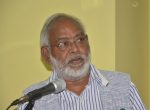Right through school I hated history, perhaps for the stupid way that it was taught. However, as I became more and more involved with people, I discovered the wonder of history, and its direct bearing on our present day lives.
My twin sister is the head of the Department of History at a renowned university. But I am a college dropout. There is a saying that fools will enter where angels fear to tread. Perhaps because a fool, like me, has no reputation to lose!
So I tread on a journey that others may dread – to try and understand the history and mystery of Yoga. In my previous article on the subject I was relatively subjective. This is different. It is a dispassionate and objective look at Yoga.
I approach this study with reverence and humility, full well knowing that little knowledge is dangerous. Hence I have had recourse to the works of two masters of Indian history – Drs Romila Thapar and A.L. Basham. The former, a Professor Emeritus of Jawaharlal Nehru University, New Delhi, is better known.
Arthur Basham, a Britisher, was more Indian than most of us. His classic work, “The Wonder that was India” is a must, together with Thapar’s work, for all aspirants to the Indian civil services. He has received honorary degrees from the Kurukshetra and Nalanda Universities, among others.
I say this because I am normally circumspect about non-Indians writing about India. However, Basham’s credentials are so impeccable that one must submit to the genius and genuineness of his scholarship; even though we may not necessarily subscribe to the inferences that he makes.
I begin this piece with what Thapar says in her book “The Penguin History of Early India”. To make this study reader friendly I will not be quoting/ unquoting. It is based entirely on what these eminent historians have propounded.
Patanjali is widely perceived to be the father of systematic Yoga. Both Thapar and Basham place him in the 2nd century BC. This was during the Mauryan dynasties, Buddhist rule, and an era where north India was greatly influenced by its interaction with Greek culture. Patanjali was essentially a grammarian. He systemized the Sanskrit grammar prepared by Panini, a work that is known as Mahabhasya. By modern definition I would call Patanjali a Methodist!
Thapar says that this period also saw the rise of the mercantile (trading) community that gradually evolved into shreenis (classes as distinct from caste). They organized themselves into various vocational guilds, such as for potters, weavers and goldsmiths.
A medical guild also evolved, studying both medicine and surgery, with Charaka being the most renowned. The medical system was based on the theory of three humours – air, bile and mucous; with their correct balance resulting in a healthy body.
In this era medical knowledge grew independent of Brahminical orthodoxy. It is in this era that Patanjali is placed. The question that now arises in my mind is – where is the connect between air, bile and mucous; and Yoga as we see it propounded and practiced today? Are we making false claims of antiquity as a proof of genuineness?
I have earlier taken great pains to present Basham’s credentials, because what he has to say about Yoga could be disconcerting, and could easily demythologize some popular notions. Let me place before you the fruit of his studies.
Yoga is defined as a spiritual discipline or application. It is a psychic training for the attainment of salvation. Though initially codified by Patanjali, the grammarian in the 2nd century BC, the Yoga Sutras in their present form are probably from several centuries later.
The perception of god in Yoga is similar to that of Buddhism and Jainism, with whom the worshipper never comes in contact. OM is the sacred syllable of Yoga, purifying the soul and aiding meditation. From the above one may infer that modern Yoga is very different from its spiritual origins, to which Hinduism cannot claim exclusivity. One would also have to admit that Yoga is not purely secular, as it is now being made out to be.
Patanjali’s Yoga had eight stages, again similar to the eight-fold path of Buddhism. The first stage is of self-control (yama), which includes non-violence, truthfulness and chastity. The second stage is that of observance (niyama) which includes purity, austerity, study of the Vedas and devotion to God. The third stage is that of posture (asanas) and the fourth is breath control (pranayama).
The fifth is restraint (pratyahara) where the sensory organs are numbed into feelinglessness. The sixth is the focusing of the mind (dharana) by concentrating on something like the tip of one’s nose. The seventh stage is meditation (dhyana) where the mind becomes totally focused; in turn leading to the eighth stage (samadhi). This last is akin to spiritual ecstasy where one loses oneself in the Other.
From the foregoing we may conclude that Yoga was primarily a spiritual path of self-denial and self-control in order to attain unity with the Godhead. How does the modern practice of Yoga match up with what it was originally meant to be?
Basham goes on to say that Yoga sometimes evolved in rather dubious ways, especially by the Tantrik schools of the Middle Ages. The pristine Yoga described above was known as Rajayoga (royal Yoga). Another system that evolved was Mantrayoga (incantation) that employed repetition of magical syllables to raise one to a higher level of consciousness. The third form is Hathayoga (physical force) that involves acrobatic exercises, difficult postures, and sometimes advocates sexual union as a means of salvation. The fourth is Layayoga (dissolution) based on ancient physiological notions. One may hear say that the form of Yoga on display on the International Yoga Day was basically Hathyoga. However, the reference to sex could also explain why some gurus like Rajneesh became very popular in the West. Finding God through sex – instant nirvana!
Hathayoga and Layayoga are based on the premise that the chief vein of the body (susumna) runs through the spinal column, through six discs (chakras) that are concentrations of psychic energy. The highest chakra (sahasrara) is in the skull, and the lowest is the kundalini (serpent power) located behind the genitals. Yogic practices awaken the kundalini shakti that rises through the vein and the chakras to the sahasrara. The yogi thereby gains spiritual strength and attains salvation. The awakened kundalini gives the yogi superhuman power and knowledge.
Now comes the rider. Basham concludes this section by saying that the physiological basis of layayoga and hathayoga is false as there is no such thing as kundalini, susumna or sahasrara. Despite this observation Basham admits that an advanced yogi can hold his breath for long periods, control his heartbeats, withstand extremes of heat and cold, remain healthy on a starvation diet and often survive to a very advanced age with full use of his faculties.
As I said at the beginning of this piece, I have little knowledge. But I do believe that there is a nerve (spinal chord) that runs through the body. As I said in my previous piece, I do believe that the pneuma and the psyche (spiritual and mental faculties) do have a major impact on the soma (physical properties). Hence I would daresay that Yoga has both its virtues and its limitations, as also possible distortions. It should also be subjected to modern scientific investigation.
In my previous piece I had mentioned that I was unable to meet my homeopathic doctor. I did subsequently meet her and she queried me for a good 30 minutes. Other than the routine questions about what I ate or drank, she asked me several apparently “unrelated” questions – like my sleeping posture, nature of dreams, fear of heights, anger control etc. So was my doctor a yogi? Yes, a karmayogi who was able to co-relate body and mind for holistic healing. She further confirmed my belief that homeopathy is best for addressing psychosomatic ailments. Homeopathy seeks to address the root causes, and not just the symptoms, as allopathy does.
While reflecting on the eight stages of rajayoga I found many parallels with the mystical experiences of St Theresa of Avila (in Spain in the 16th century) who is considered the greatest Christian mystic. In her book “Interior Castle” she refers to seven rooms or mansions through which the seeker must pass before attaining spiritual union (ecstasy) with the Divine. It is a state in which all thoughts and feelings are annihilated while attaining this level of spiritual consciousness.
In this context I feel a certain sadness that the lofty goals of rajayoga do not find much mention in modern discourse or yogic practices. Yoga gurus across the globe seem to have opted for a universally acceptable or pleasurable form of hathayoga. Be that as it may, let us take all the good things from the four branches of Yoga, and hope that it helps to bring wellness and peace, as proclaimed at the International Yoga Day.
(The writer would prefer to classify himself as a premyogi or sevayogi. There shouldn’t be any dispute about that!)










